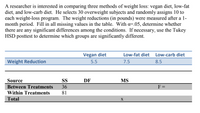
MATLAB: An Introduction with Applications
6th Edition
ISBN: 9781119256830
Author: Amos Gilat
Publisher: John Wiley & Sons Inc
expand_more
expand_more
format_list_bulleted
Concept explainers
Topic Video
Question
What are the missing values for Between and Within treatment, in terms of DF, MS and F?

Transcribed Image Text:A researcher is interested in comparing three methods of weight loss: vegan diet, low-fat
diet, and low-carb diet. He selects 30 overweight subjects and randomly assigns 10 to
each weight-loss program. The weight reductions (in pounds) were measured after a 1-
month period. Fill in all missing values in the table. With a=.05, determine whether
there are any significant differences among the conditions. If necessary, use the Tukey
HSD posttest to determine which groups are significantly different.
Vegan diet
Low-fat diet Low-carb diet
Weight Reduction
5.5
7.5
8.5
Source
SS
DF
MS
Between Treatments
36
F =
Within Treatments
81
Total
X
Expert Solution
This question has been solved!
Explore an expertly crafted, step-by-step solution for a thorough understanding of key concepts.
This is a popular solution
Trending nowThis is a popular solution!
Step by stepSolved in 4 steps

Knowledge Booster
Learn more about
Need a deep-dive on the concept behind this application? Look no further. Learn more about this topic, statistics and related others by exploring similar questions and additional content below.Similar questions
- Estimate the sales when the test score of a salesman is 19.5.arrow_forwardA researcher reports an F-ratio with df=4,98 for an independent-measures research study.How many treatment conditions were compared in the study? How many individuals participated in the entire study?arrow_forwardWhich of the following formulas is correct for converting raw scores to z scores? Which of the following formulas is correct for converting raw scores to z scores? Z = X+M/SD Z = (X-M)/SD Z = (X+M)/SD Z = (X(SD))/M Z = (M-X)/SDarrow_forward
- An instructor for a test preparation course claims that the course will improve the test scores of students. The table shows the critical reading scores for 14 students the first two times they took the test. Before taking the test for the second time, the students took the instructor's course to try to improve their critical reading test scores. At a = 0.01, is there enough evidence to support the instructor's claim? Complete parts (a) through (f). Student 1 2 3 4 7 8 10 11 12 13 14 Score on first test 366 449 434375 426 507501 337 347544 428 558 401 410 Score on second test 375515 497 406 381 536 455454 406 596 474 583 441 447arrow_forwardA researcher evaluated the effectiveness of relaxation training in reducing anxiety. One sample of anxiety ridden people received relaxation training, while a second sample did not. Then anxiety scores were measured for all subjects, using a standardized test. Us the information summarized in the following table to complete this item. The Effect of Relaxation Training on Anxiety Scores Group Mean Anxiety Score SE Control group 36 12 Relaxation training 18 10 What is the DV (remember, the DV is the data)? What is the level of measurement of the DV? What is the best graph to display this data? Explainarrow_forwardAre the digits of your R-number a quantitative or qualitative variable?arrow_forward
- What is the type of the variable "The barcode of items displayed in a supermarket"? a. Quantitative - Discrete O b. Qualitative - Nominal Oc. Quantitative - Continuous Od Qualitative - Ordinalarrow_forwardA researcher reports an F-ratio with df = 2, 18 from an independent measures research study. Based on the df values, how many treatments were compared in the study, and what was the total number of subjects participating in the study? Number of Treatments _____ Number of Subjects _____arrow_forwardApparently what I put was incorrect.arrow_forward
- A researcher reports an F-ratio with df = 3, 56 from an independent-measures research study. How many treatment conditions were compared in the study? How many participants were in the study?arrow_forward1. Was a dependent or independent t-test used to analyze the data? How do you know?arrow_forwardimprovements to the experimental design?arrow_forward
arrow_back_ios
SEE MORE QUESTIONS
arrow_forward_ios
Recommended textbooks for you
 MATLAB: An Introduction with ApplicationsStatisticsISBN:9781119256830Author:Amos GilatPublisher:John Wiley & Sons Inc
MATLAB: An Introduction with ApplicationsStatisticsISBN:9781119256830Author:Amos GilatPublisher:John Wiley & Sons Inc Probability and Statistics for Engineering and th...StatisticsISBN:9781305251809Author:Jay L. DevorePublisher:Cengage Learning
Probability and Statistics for Engineering and th...StatisticsISBN:9781305251809Author:Jay L. DevorePublisher:Cengage Learning Statistics for The Behavioral Sciences (MindTap C...StatisticsISBN:9781305504912Author:Frederick J Gravetter, Larry B. WallnauPublisher:Cengage Learning
Statistics for The Behavioral Sciences (MindTap C...StatisticsISBN:9781305504912Author:Frederick J Gravetter, Larry B. WallnauPublisher:Cengage Learning Elementary Statistics: Picturing the World (7th E...StatisticsISBN:9780134683416Author:Ron Larson, Betsy FarberPublisher:PEARSON
Elementary Statistics: Picturing the World (7th E...StatisticsISBN:9780134683416Author:Ron Larson, Betsy FarberPublisher:PEARSON The Basic Practice of StatisticsStatisticsISBN:9781319042578Author:David S. Moore, William I. Notz, Michael A. FlignerPublisher:W. H. Freeman
The Basic Practice of StatisticsStatisticsISBN:9781319042578Author:David S. Moore, William I. Notz, Michael A. FlignerPublisher:W. H. Freeman Introduction to the Practice of StatisticsStatisticsISBN:9781319013387Author:David S. Moore, George P. McCabe, Bruce A. CraigPublisher:W. H. Freeman
Introduction to the Practice of StatisticsStatisticsISBN:9781319013387Author:David S. Moore, George P. McCabe, Bruce A. CraigPublisher:W. H. Freeman

MATLAB: An Introduction with Applications
Statistics
ISBN:9781119256830
Author:Amos Gilat
Publisher:John Wiley & Sons Inc

Probability and Statistics for Engineering and th...
Statistics
ISBN:9781305251809
Author:Jay L. Devore
Publisher:Cengage Learning

Statistics for The Behavioral Sciences (MindTap C...
Statistics
ISBN:9781305504912
Author:Frederick J Gravetter, Larry B. Wallnau
Publisher:Cengage Learning

Elementary Statistics: Picturing the World (7th E...
Statistics
ISBN:9780134683416
Author:Ron Larson, Betsy Farber
Publisher:PEARSON

The Basic Practice of Statistics
Statistics
ISBN:9781319042578
Author:David S. Moore, William I. Notz, Michael A. Fligner
Publisher:W. H. Freeman

Introduction to the Practice of Statistics
Statistics
ISBN:9781319013387
Author:David S. Moore, George P. McCabe, Bruce A. Craig
Publisher:W. H. Freeman